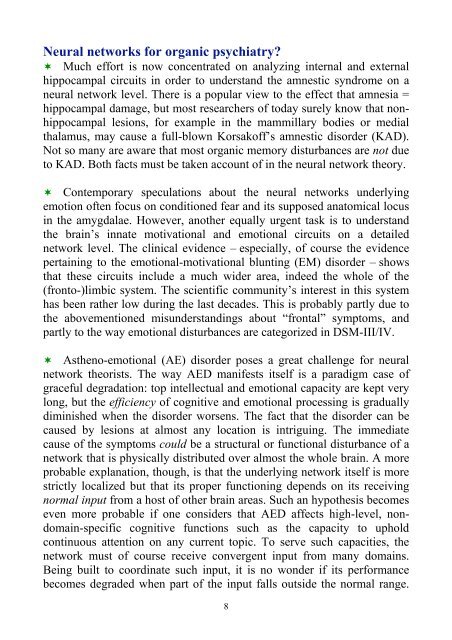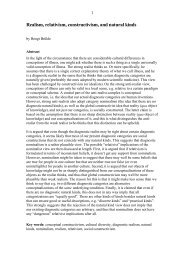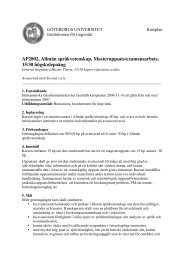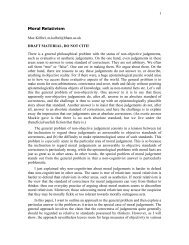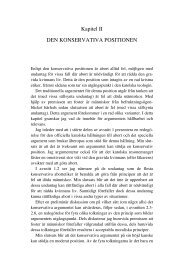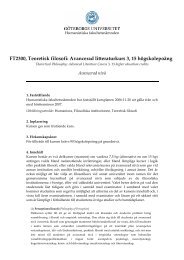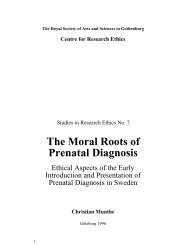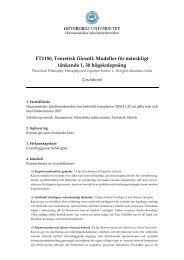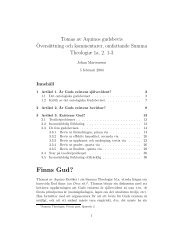Memory, emotion and brain injury Memory, emotion and brain injury
Memory, emotion and brain injury Memory, emotion and brain injury
Memory, emotion and brain injury Memory, emotion and brain injury
You also want an ePaper? Increase the reach of your titles
YUMPU automatically turns print PDFs into web optimized ePapers that Google loves.
Neural networks for organic psychiatry<br />
Much effort is now concentrated on analyzing internal <strong>and</strong> external<br />
hippocampal circuits in order to underst<strong>and</strong> the amnestic syndrome on a<br />
neural network level. There is a popular view to the effect that amnesia =<br />
hippocampal damage, but most researchers of today surely know that nonhippocampal<br />
lesions, for example in the mammillary bodies or medial<br />
thalamus, may cause a full-blown Korsakoff’s amnestic disorder (KAD).<br />
Not so many are aware that most organic memory disturbances are not due<br />
to KAD. Both facts must be taken account of in the neural network theory.<br />
Contemporary speculations about the neural networks underlying<br />
<strong>emotion</strong> often focus on conditioned fear <strong>and</strong> its supposed anatomical locus<br />
in the amygdalae. However, another equally urgent task is to underst<strong>and</strong><br />
the <strong>brain</strong>’s innate motivational <strong>and</strong> <strong>emotion</strong>al circuits on a detailed<br />
network level. The clinical evidence – especially, of course the evidence<br />
pertaining to the <strong>emotion</strong>al-motivational blunting (EM) disorder – shows<br />
that these circuits include a much wider area, indeed the whole of the<br />
(fronto-)limbic system. The scientific community’s interest in this system<br />
has been rather low during the last decades. This is probably partly due to<br />
the abovementioned misunderst<strong>and</strong>ings about “frontal” symptoms, <strong>and</strong><br />
partly to the way <strong>emotion</strong>al disturbances are categorized in DSM-III/IV.<br />
Astheno-<strong>emotion</strong>al (AE) disorder poses a great challenge for neural<br />
network theorists. The way AED manifests itself is a paradigm case of<br />
graceful degradation: top intellectual <strong>and</strong> <strong>emotion</strong>al capacity are kept very<br />
long, but the efficiency of cognitive <strong>and</strong> <strong>emotion</strong>al processing is gradually<br />
diminished when the disorder worsens. The fact that the disorder can be<br />
caused by lesions at almost any location is intriguing. The immediate<br />
cause of the symptoms could be a structural or functional disturbance of a<br />
network that is physically distributed over almost the whole <strong>brain</strong>. A more<br />
probable explanation, though, is that the underlying network itself is more<br />
strictly localized but that its proper functioning depends on its receiving<br />
normal input from a host of other <strong>brain</strong> areas. Such an hypothesis becomes<br />
even more probable if one considers that AED affects high-level, nondomain-specific<br />
cognitive functions such as the capacity to uphold<br />
continuous attention on any current topic. To serve such capacities, the<br />
network must of course receive convergent input from many domains.<br />
Being built to coordinate such input, it is no wonder if its performance<br />
becomes degraded when part of the input falls outside the normal range.<br />
8


